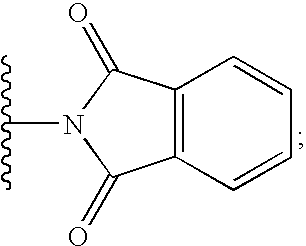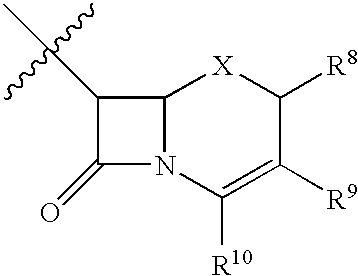Inhibitors of 15-lipoxygenase
a technology of 15-lipoxygenase and inhibitors, which is applied in the direction of biocide, heterocyclic compound active ingredients, organic chemistry, etc., can solve the problems of serious disorders
- Summary
- Abstract
- Description
- Claims
- Application Information
AI Technical Summary
Benefits of technology
Problems solved by technology
Method used
Image
Examples
example 1
N-[5-(2-Azido-ethyl)-4-(4-methoxy-phenyl)-thiazol-2-yl]-acetamide
A. 4-Azido-1-(4-methoxy-phenyl)-butan-1-one
To a solution of 4-chloro-4′-methoxybutyrophenone (Acros Organics) (22.45 g, 106 mmol) in DMF (300 mL) was added sodium azide (13.7 g, 211 mmol). The solution was heated under N2 (g) at 70° C. for 4 h. The milky reaction mixture was partitioned between ethyl acetate (700 mL) and water (500 mL). The organic layer was washed with another portion of water (500 mL), followed by saturated aqueous sodium bicarbonate (500 mL) and brine (500 mL). The organic layer was dried (sodium sulfate) and concentrated to give an oil (22 g, 95% yield) which solidified slowly upon standing. MS m / e 220; HPLC retention time 3.09 min.
B. 4-Azido-2-bromo-1-(4-methoxy-phenyl)-butan-1-one
To a solution of 1A (21.67 g, 98.9 mmol) in 1,4-dioxane (300 mL) was added bromine (5.07 mL, 98.9 mmol) dropwise. After 20 min at ambient temperature, the reaction mixture was concentrated in vacuo and the resid...
example 2
N-{4-(4-Methoxy-phenyl)-5-[2-(4-pentyl-benzenesulfonylamino)-ethyl]-thiazol-2-yl}-acetamide
A. N-[5-(2-Amino-ethyl)-4-(4-methoxy-phenyl)-thiazol-2-yl]-acetamide
A mixture of 1C (53 mg, 0.17 mmol) and triphenylphosphine (43 mg, 0.17 mmol) in acetonitrile (0.43 mL) and water (0.032 mL) was heated at 60° C. for 14 h. The reaction mixture was filtered through a syringe-tip filter (0.45 μm, PTFE) and purified by reverse phase preparative LC to give the product TFA salt as a white solid (38 mg, 56% yield). MS m / e 292; HPLC retention time 1.63 min.
B. N-{4-(4-Methoxy-phenyl)-5-[2-(4-pentyl-benzenesulfonylamino)-ethyl]-thiazol-2-yl}-acetamide
To a mixture of the amine trifluoroacetic acid salt 2A (38 mg, 0.094 mmol) and N,N-diisopropylethylamine (0.25 mL, 1.44 mmol) in dichloromethane (1.0 mL) at 0° C. was added 4-pentylbenzene-1-sulfonyl chloride (30 mg, 0.12 mmol). After 1.5 h, the reaction mixture was partitioned between ethyl acetate (20 mL) and 1 N HCl (20 mL). The organic layer w...
example 3
N-{4-(4-Methoxy-phenyl)-5-[2-(4-pentyl-benzenesulfonylamino)-ethyl]-thiazol-2-yl}-butyramide
A. 5-(2-Azido-ethyl)-4-(4-methoxy-phenyl)-thiazol-2-ylamine
A solution of the bromoketone 1B (223 mg, 0.75 mmol) and thiourea (57 mg, 0.75 mmol) in dry ethyl alcohol (2 mL) was heated for 5 min at 120° C. in a microwave reactor (Smith reactor, Personal Chemistry). The reaction mixture was concentrated and purified by preparative HPLC to give the product TFA salt as a white solid (210 mg, 72% yield). MS m / e 276.
B. N-[5-(2-Azido-ethyl)-4-(4-methoxy-phenyl)-thiazol-2-yl]-butyramide
To a solution of the amine 3A (210 mg, 0.54 mmol) and N,N-diisopropylethylamine (0.263 mL, 1.51 mmol) in dichloromethane (5 mL) at 0° C. was added butyryl chloride (0.067 mL, 0.65 mmol). The reaction mixture was allowed to warm to room temperature over 1 h, then partitioned between ethyl acetate (20 mL) and 1N aqueous HCl (20 mL). The organic layer was washed with saturated aqueous sodium bicarbonate (2×10 mL) ...
PUM
| Property | Measurement | Unit |
|---|---|---|
| density | aaaaa | aaaaa |
| elasticity | aaaaa | aaaaa |
| brittle | aaaaa | aaaaa |
Abstract
Description
Claims
Application Information
 Login to View More
Login to View More - R&D
- Intellectual Property
- Life Sciences
- Materials
- Tech Scout
- Unparalleled Data Quality
- Higher Quality Content
- 60% Fewer Hallucinations
Browse by: Latest US Patents, China's latest patents, Technical Efficacy Thesaurus, Application Domain, Technology Topic, Popular Technical Reports.
© 2025 PatSnap. All rights reserved.Legal|Privacy policy|Modern Slavery Act Transparency Statement|Sitemap|About US| Contact US: help@patsnap.com



